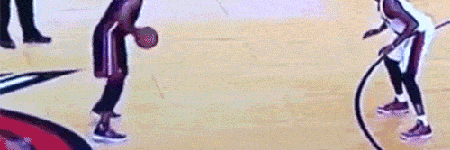Barring any last-minute glitches, hoops fans will have access, starting on Friday, to such passing stats, and a whole new set of data delivering new layers of insight into basketball. On NBA.com’s expanded statistics page, fans will be able to see and sort info from STATS LLC’s SportVU Player Tracking system. In all 29 NBA arenas — there are 30 NBA teams, but remember, the Los Angeles Clippers and Lakers share the Staples Center — six cameras are installed in catwalks, tracking the movement of every player. A software program ingests all the data and spits out statistics like assist opportunities, the distance each player travels during a game (on Tuesday’s opening night, Blake Griffin ran 2.71 miles, tops among the six teams that played), and a player’s defensive impact (the Orlando Magic made just three of nine shots against Indiana’s 7’2″ center Roy Hibbert while Hibbert was defending the rim).
Rebounds also get a makeover. The total number of rebounds a player compiles often depends on factors outside his control. If the opposing team is shooting badly, for example, you can snatch more bricks off the boards. What’s more relevant: if a player is near the ball, at what rate does he go and grab it? “Rebound Chances” measures the number of times a player is within 3.5 feet of a rebound during a game: from there, SportVU calculates a player’s “rebound percentage,” based on the number of boards he actually grabs.
TIME got a sneak peak at the NBA’s Player Tracking site; it’s informative and easy to navigate. Other subcaterogies include a player’s performance when he drives to the basket, and how effective he is when he just catches the ball and shoots. In Miami’s first game, a 107-95 win over Chicago, Shane Battier, the king of finding himself open as Miami’s star players drive to the basket, shot four-for-four from three point range after catching, squaring, and firing away. A personal, if somewhat random, favorite: the data tells you how fast, on average, players were moving in a game. Congratulations to rookie Tony Snell and veteran Mike Dunleavy, both of the Chicago Bulls: you were the fastest players on Tuesday night, each moving an average of 4.9 miles per hour.
SportsVU data goes public on Friday
8 posts
• Page 1 of 1
SportsVU data goes public on Friday
http://keepingscore.blogs.time.com/2013 ... n-the-nba/
-

benji - Posts: 14545
- Joined: Sat Nov 16, 2002 9:09 am
Re: SportsVU data goes public on Friday
I doubt it's capable of measuring the way LeBron chokes.
- shadowgrin
- Doesn't negotiate with terrorists. NLSC's Jefferson Davis. The Questioneer
- Posts: 23229
- Joined: Thu Dec 12, 2002 6:21 am
- Location: In your mind
Re: SportsVU data goes public on Friday
I was just excited season is back. Now this. OMGGGGGGGGGGGGGG

Enjoy! <3 Jao
-

NovU - Crap, what am I going to brag about now?
- Posts: 11325
- Joined: Tue Jun 05, 2007 6:50 pm
Re: SportsVU data goes public on Friday
This is going to drive stat nuts like me absolutely crazy. 
We can do all this and we can't get robots to referee games?
We can do all this and we can't get robots to referee games?
-

rise - But here, at the top of the world, where I raise my hands and I clench my fists...

- Posts: 5266
- Joined: Tue Apr 13, 2010 9:52 am
- Location: buzz city
Re: SportsVU data goes public on Friday
rise wrote:This is going to drive stat nuts like me absolutely crazy.
You're a stat nut and yet you don't know that Kidd-Gilchrist is terrible?
- shadowgrin
- Doesn't negotiate with terrorists. NLSC's Jefferson Davis. The Questioneer
- Posts: 23229
- Joined: Thu Dec 12, 2002 6:21 am
- Location: In your mind
Re: SportsVU data goes public on Friday
shadowgrin wrote:rise wrote:This is going to drive stat nuts like me absolutely crazy.
You're a stat nut and yet you don't know that Kidd-Gilchrist is terrible?
No, I watch the games and see the potential in him.
Besides, take the rookie seasons of a lot of better players (like Paul George, Shawn Marion, Gerald Wallace, Andre Iguodala) and MKG's rookie year is right there with them.
-

rise - But here, at the top of the world, where I raise my hands and I clench my fists...

- Posts: 5266
- Joined: Tue Apr 13, 2010 9:52 am
- Location: buzz city
Re: SportsVU data goes public on Friday
So which company is going to use this technology to help their video game?
- Patr1ck
- Administrator

- Posts: 13344
- Joined: Thu May 19, 2005 5:54 pm
- Location: Pasadena, California, US
Re: SportsVU data goes public on Friday
rise wrote:No, I watch the games and see the potential in him.
Besides, take the rookie seasons of a lot of better players (like Paul George, Shawn Marion, Gerald Wallace, Andre Iguodala) and MKG's rookie year is right there with them.
Same way Kwame Brown had potential.
All those players you mentioned can shoot from an area outside of 3 feet from the basket and can defend (DWS, WS/48) better than Kidd-Gilchrist during their rookie year.
- shadowgrin
- Doesn't negotiate with terrorists. NLSC's Jefferson Davis. The Questioneer
- Posts: 23229
- Joined: Thu Dec 12, 2002 6:21 am
- Location: In your mind
8 posts
• Page 1 of 1
Who is online
Users browsing this forum: No registered users and 12 guests
